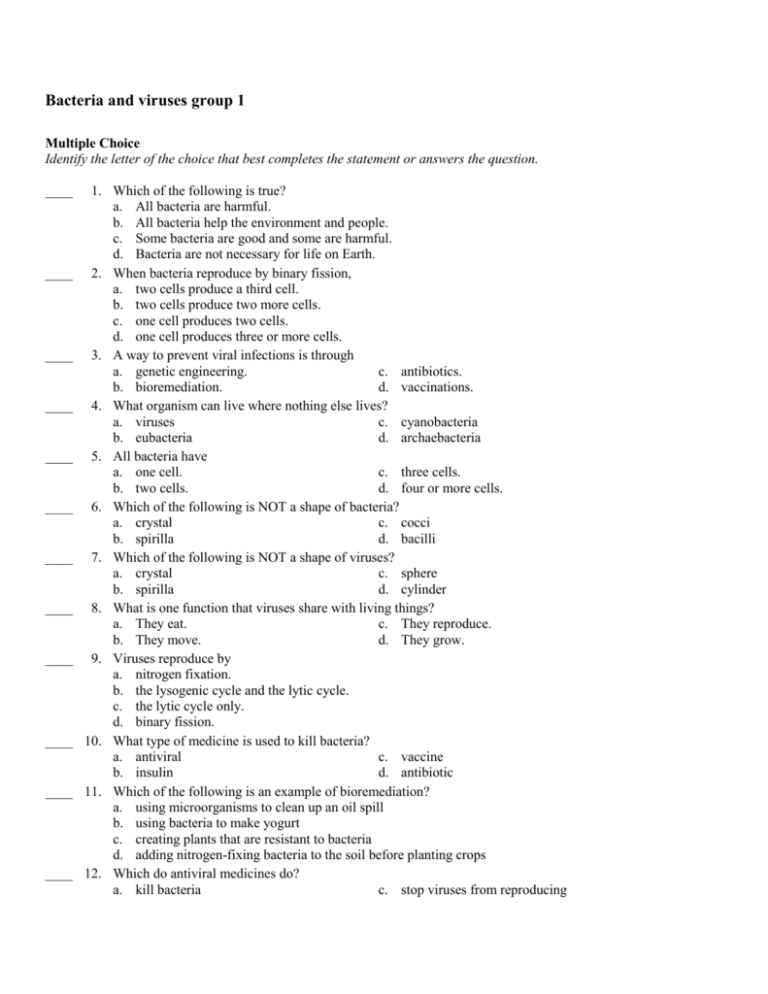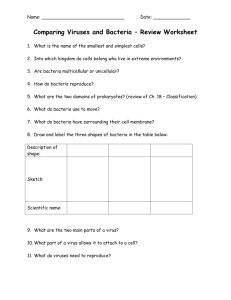Bacteria and viruses group 1
advertisement

Bacteria and viruses group 1 Multiple Choice Identify the letter of the choice that best completes the statement or answers the question. ____ ____ ____ ____ ____ ____ ____ ____ ____ ____ ____ ____ 1. Which of the following is true? a. All bacteria are harmful. b. All bacteria help the environment and people. c. Some bacteria are good and some are harmful. d. Bacteria are not necessary for life on Earth. 2. When bacteria reproduce by binary fission, a. two cells produce a third cell. b. two cells produce two more cells. c. one cell produces two cells. d. one cell produces three or more cells. 3. A way to prevent viral infections is through a. genetic engineering. c. antibiotics. b. bioremediation. d. vaccinations. 4. What organism can live where nothing else lives? a. viruses c. cyanobacteria b. eubacteria d. archaebacteria 5. All bacteria have a. one cell. c. three cells. b. two cells. d. four or more cells. 6. Which of the following is NOT a shape of bacteria? a. crystal c. cocci b. spirilla d. bacilli 7. Which of the following is NOT a shape of viruses? a. crystal c. sphere b. spirilla d. cylinder 8. What is one function that viruses share with living things? a. They eat. c. They reproduce. b. They move. d. They grow. 9. Viruses reproduce by a. nitrogen fixation. b. the lysogenic cycle and the lytic cycle. c. the lytic cycle only. d. binary fission. 10. What type of medicine is used to kill bacteria? a. antiviral c. vaccine b. insulin d. antibiotic 11. Which of the following is an example of bioremediation? a. using microorganisms to clean up an oil spill b. using bacteria to make yogurt c. creating plants that are resistant to bacteria d. adding nitrogen-fixing bacteria to the soil before planting crops 12. Which do antiviral medicines do? a. kill bacteria c. stop viruses from reproducing ____ 13. ____ 14. ____ 15. ____ 16. ____ 17. ____ 18. ____ 19. ____ 20. ____ 21. ____ 22. ____ 23. b. kill viruses d. cure viral infections Which of the following is NOT a common shape of bacteria? a. spirilla c. bacilli b. cocci d. crystal A cell with no nucleus is called a(n) a. prokaryote. c. host. b. endospore. d. eukaryote. Which of the following is NOT a common shape of viruses? a. crystal c. cylinder b. cocci d. sphere How many cells do bacteria have? a. one c. three b. two d. four or more How do bacteria help the environment? a. Bacteria keep nitrogen away from plants. b. Bacteria recycle dead animals and plants. c. Bacteria cause disease. d. Bacteria cause cavities. How do viruses reproduce? a. by means of the lytic cycle b. by means of the lysogenic cycle c. by means of the lytic cycle and lysogenic cycle d. by means of binary fission What organism can live where no other organisms live? a. archaebacteria c. cyanobacteria b. eubacteria d. viruses Which of the following is a shape of bacteria? a. sphere c. oval b. bacilli d. cylinder Which of the following is a shape of viruses? a. crystal c. spirilla b. cocci d. bacilli What is one way to prevent viral infections? a. bioremediation c. vaccinations b. genetic engineering d. antibiotics What is one way viruses are like living things? a. They eat. c. They grow. b. They move. d. They reproduce. Matching Match each item with the correct statement. a. endospore b. eukaryote c. cynobacteria d. eubacteria e. archaebacteria f. g. h. i. j. binary fission prokaryote flagella methane maker heat lover ____ ____ ____ ____ ____ ____ ____ ____ ____ ____ 24. 25. 26. 27. 28. 29. 30. 31. 32. 33. reproduction in which a single-celled organism splits into two single-celled organisms a type of archaebacteria that lives in swamps and animal intestines hairlike parts of bacteria that help them move around a thick-walled spore containing genetic material and proteins that forms inside a bacterial cell an organism with a nucleus the most common kind of bacteria a single-celled organism with no nucleus bacteria that contain the green pigment chlorophyll bacteria that often live in harsh environments a type of archaebacteria that lives in ocean vents and hot springs Match each item with the correct statement. a. antibiotic b. pathogenic bacteria c. genetic engineering ____ ____ ____ ____ ____ ____ 34. 35. 36. 37. 38. 39. the use of microorganisms to treat hazardous waste the process in which bacteria change nitrogen in the air into a form that plants can use bacteria that cause disease the sugar in milk medicine used to treat many bacterial diseases changes in the genes of bacteria or other living things Match each item with the correct statement. a. oxygen b. lytic cycle c. host d. protein coat e. antibiotics ____ ____ ____ ____ ____ ____ ____ ____ ____ ____ 40. 41. 42. 43. 44. 45. 46. 47. 48. 49. d. nitrogen fixation e. lactose f. bioremediation f. g. h. i. j. shape antiviral virus vaccinations lysogenic cycle a microscopic particle that gets inside a cell and often destroys it a cycle in which a virus’s genes live in a host but are inactive the substance that protects a virus’s genetic material and helps it get inside a cell a way to prevent viral infections a cycle in which a virus attacks a host and causes it to make viruses something viruses cannot use one way viruses are grouped medicine that does not kill viruses a living thing that a virus or parasite lives on or in a type of medicine that keeps viruses from reproducing Match each item with the correct statement. a. decomposers b. prokaryote c. producers ____ 50. an organism that cannot live on its own ____ 51. eubacteria that make their own food ____ 52. bacteria that break down dead organisms d. eubacteria e. virus f. cyanobacteria ____ 53. an organism with no nucleus ____ 54. bacteria that contain chlorophyll ____ 55. the most common type of bacteria Match each item with the correct statement. a. virus b. host c. pathogenic bacteria ____ ____ ____ ____ ____ 56. 57. 58. 59. 60. thick-walled cells in which bacteria store genetic material an organism that invades a cell and uses it to create more organisms bacteria that cause disease use of bacteria to change harmful chemicals to harmless ones type of cell in which viruses reproduce Match each item with the correct statement. a. prokaryote b. virus ____ ____ ____ ____ 61. 62. 63. 64. 65. 66. 67. 68. c. pathogenic bacteria d. host bacteria that cause disease an organism without a nucleus a tiny organism that invades a cell and destroys it a living thing that a virus lives on or in Match each item with the correct statement. a. antivirals b. antibiotics ____ ____ ____ ____ d. endospores e. bioremediation c. vaccinations d. bioremediation medicines that kill bacteria medicines that keep viruses from reproducing changing harmful chemicals to harmless ones a way to prevent viral infections Short Answer 69. Explain how the first plant cell could have evolved with the help of bacteria. 70. Describe three ways that bacteria are helpful. 71. How are viruses like and unlike living things? 72. Define bioremediation. 73. What advantage do cocci-shaped bacteria have over bacilli-shaped bacteria? 74. Which organism do you think is more dangerous, a virus or a bacterium? Explain your answer. 75. If life existed on other planets, what type of organism do you think it would most likely be? Essay 76. What technological advances have triggered the spread of viruses? Explain your answer. 77. Hypothesize why antibiotics can kill bacteria but do not kill viruses. 78. Imagine you were having a conversation with a person who had never heard of viruses. Explain what you would tell them about the importance of preventing infections from viruses.







